By: Lee Carney
Introduction
Every weekend of the year, at hundreds of locations around North America, people gather to race motorized vehicles of every description. From stock cars to motorcycles, from open wheel cars to power boats, motor racing is a grand spectacle of speed and power. The bright colours, the blazing speed and the unique environment make motor races an exciting place to create memorable images. The skills you need to capture effective images of motor racing are very unique, however, and it’s hard to find "How To" books on this subject!
Over the last several years, I have been taking photographs at theMolson Indy Toronto. The race is one of the events in theCART FedEx Championship Series, one of North America’s premier motor racing series. I have prepared this article to share the lessons I have learned about photographing racing.
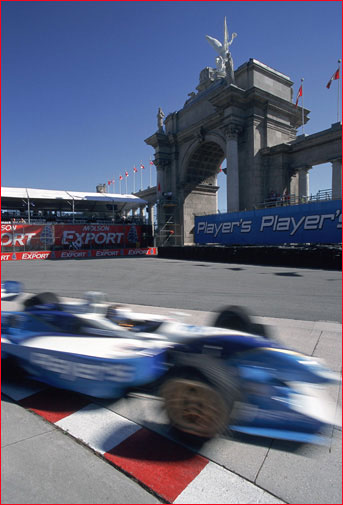 "Blur at Prince’s Gates" Molson Indy Toronto 2002
"Blur at Prince’s Gates" Molson Indy Toronto 2002
EOS 1-V and EF 20mm F/2.8 lens, 1/80th at f/16 on Provia 100F
Access
TheMolson Indy Torontoand many other races offer a special ticket for photographers: aSuper Photo Pass. They are not cheap (in Toronto they cost US$275), but they allow access to the pits and to most of the good trackside shooting areas. In Toronto, there are also special towers provided for photographers to get a unique birds-eye view of key locations on the track. If you aren’t lucky enough to know somebody who can get you media credentials, these passes are the only way to get the access you need to make interesting photographs at the race. Trying to shoot the race from the grandstands is all but impossible. The cars are simply too small, and you will be too far away for your images to capture any of the speed that race cars posses.
There are two main areas that you can shoot from: In the pit lane, and beside the track. The pit lane is where the drivers stop to refuel and where the crews make adjustments to the cars. It’s a crowded, noisy place, but there is a lot of action. Photographers are welcome to shoot from behind the team’s equipment, and with a medium telephoto lens you can get some interesting shots. There are certain times that you are allowed to go "over the wall" and onto pit lane itself, but these "Pit Walk-Throughs" are open to non-photographers as well. There are usually too many people milling about to allow for any good photographic opportunities.
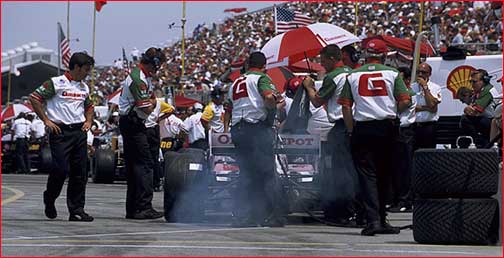 "Start Your Engines" Molson Indy Toronto 2002
"Start Your Engines" Molson Indy Toronto 2002
EOS 1-V and 70-200mm F/2.8L lens, 1/400th at f/7.1 on Provia 100F
The other excellent shooting locations are trackside. This is the area between the debris fence and retaining walls that line the track and the front of the grandstands. Access to these areas puts you much closer to the track than any normal ticket-buying fan can get. All that separates you from the cars on the track is a concrete "jersey wall" and some debris fencing. In certain locations the race organizers cut out small sections of the debris fence to provide photographers and members of the media an unobstructed view onto the track. The best holes will be *very* busy places — it’s not uncommon to see a dozen photographers crowded around a 2′ x 2′ cut-out.
The Pros
While you are shooting at the track, you will almost certainly be shoulder-to-shoulder with working professional photographers. In the years that I’ve been shooting the race in Toronto, I have had the good fortune of meeting many of the photographers whose work I’ve long admired (such as Peter Burke of Champcar.com). Keep in mind that their income depends on gettingThe Shotof the race’s decisive moment. If you are an amateur photographer who paid $275 to be there, you have a right to shoot the race too. But please remember that while you are there having fun, the guy beside you is at work. Act accordingly.
Equipment
You’ll find an opportunity to use most of the lenses in your bag. You’ll need a 200mm lens at minimum, and 300mm or more is better for shooting at trackside. If it’s bright and sunny, you won’t need to shoot wide open, but some shots demand the fastest shutter speed possible. A 300mm f2.8 with Image Stabilization is perfect — when necessary, you can open up and not lose any sharpness, and the IS will help you minimize camera shake. Carrying a tripod isn’t practical, but a monopod is a must for any lens longer than 200mm. You won’t be able to use it when panning (see below), but for most other shooting it’s the only way to get usable images. For shooting in the pits, a 70-200mm plus a wide angle lens will allow you to get most of the shots you want.
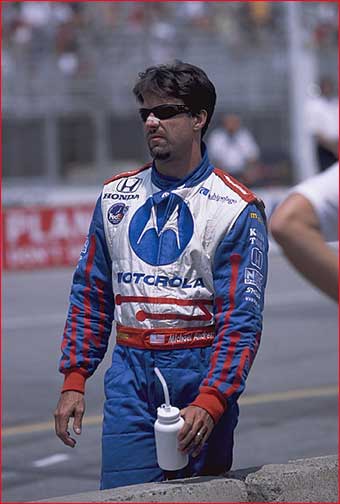 "Andretti" Molson Indy Toronto 2002
"Andretti" Molson Indy Toronto 2002
EOS 1-V and EF 70-200mm F/2.8 lens, 1/1600th at f/4 on Provia 100F
Another piece of gear that will help you stay comfortable is kneepads. Much of your shooting will be done while kneeling on concrete and asphalt, and kneepads will greatly reduce the strain.
I shot this year’s Indy with an EOS 1-V, an EF 400mm DO f4L IS, an EF 70-200mm f2.8L, an EF 28-135mm f35.-5.6 IS, an EF 17-35mm f2.8L and an EF 20mm f2.8. I used a Manfrotto 434 monopod, and carried everything in a Lowepro Street & Field Reporter bag.
There are two schools of thought when it comes to choosing film. I have always used Provia 100F at the track, but some people swear by print film instead. You can under or over expose print film to a greater degree than transparency film, but I am unwilling to give up the sharpness and colour saturation of Provia. Use what you are comfortable with, but whichever film you choose, bring more than you think you’ll need. It’s surprisingly easy to burn through 20+ rolls of film in a day.
Safety
Motor racing is dangerous, no two ways about it. In 1996, I witnessed the horrible crash in which Jeff Krosnoff (a driver) and Gary Avrin (a volunteer track worker) were killed. The tree that shattered Jeff’s car is still there, right beside Lakeshore Boulevard, and serves as a grim reminder of the risks involved in this sport. Nobody goes to a race expecting to be injured, but it does happen. Fortunately there are things you can do to minimize your risk.
Never turn your back to a car on the track. You can’t jump out of the way of something you don’t see coming. If you are shooting with a long lens, try and get a buddy to "spot" for you. With the camera up to your eye, your field of vision is extremely small and chances are you won’t see an out-of-control car coming at you. Your buddy can pull you down to the ground or out of the way if necessary. And make it a habit of always knowing where you would dive if you saw a car careening towards you. If the spot you are in has no escape route, find somewhere else to shoot from.
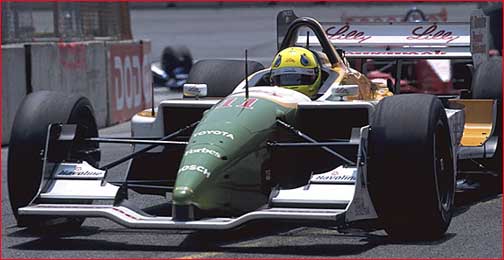 "Fittipaldi Accelerates" Molson Indy Toronto 2002
"Fittipaldi Accelerates" Molson Indy Toronto 2002
EOS 1-V and 70-200mm F/2.8 lens, 1/800th at f/5.6 on Provia 100F
Never lean on or put your gear down on the concrete barriers that line the track. They are the only thing that stands between you and a 180 mph, 1,500 lb projectile. If a car hits the barrier, the barrier is going to move and you don’t want to be leaning on it when it does. And if your spare lens or camera bag is sitting on the concrete, it is going to go flying. Put your gear on the ground beside you, remembering not to block your escape route.
Wear really good ear protection. Get the kind that construction workers use to protect their ears from hydraulic jackhammers. You will be just a few feet away from a few dozen 800 horsepower engines without mufflers, and the roar is quite literally deafening.
Wear long pants, and if it isn’t too hot, wear a long sleeved shirt. You won’t be allowed into the pit lane with shorts on, and pant legs and sleeves will afford you some protection, however small, against airborne debris or fire.
Pick your shooting locations wisely. Just because there is a cut-out in the fence doesn’t mean it’s a safe place to shoot. Watch the cars on the track — if a car loses control, where will it hit? If the cut-out in the fence is too close to the likely impact zone, move.
And finally, be aware that the last few minutes of the practice and qualifying sessions and the closing laps of the actual race are the times that the drivers will be pushing harder than usual on the track. Be extra vigilant at these times.
Technique
When shooting cars on the track, it’s important that the car fills the frame. The track and the retaining walls around the car are very uninteresting subjects. The only exception to this rule occurs when using a wide angle lens and panning with a car. This technique will blur the background and the front and back of the car, giving the impression of tremendous speed.
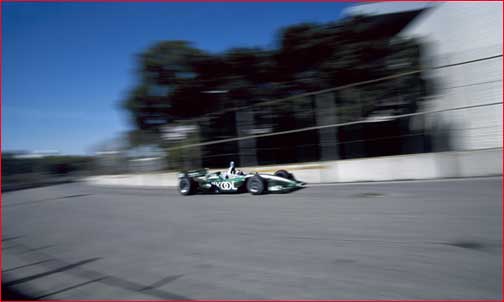 "Fast and Kool" Molson Indy Toronto 2002
"Fast and Kool" Molson Indy Toronto 2002
EOS 1-V and EF 20mm F/2.8 lens, 1/40th at f22 on Provia 100F
If your lens is long enough, close in tight and frame the drivers head, the roll bar and the front wheel of the car. Your image will be much stronger is you can also capture the driver’s hand on the steering wheel. The driver’s hand is normally only visible when they are turning, so try shooting from the outside of a corner. As with all racing photography, for this shot to work you MUST get the Drivers helmet and the roll bar in focus.
In the pits, anything goes. Shoot the cars from different angles — down low works particularly well. When shooting drivers in their cars, you need to use your flash so you don’t lose their eyes in the shadows created by their helmet. Pay attention to what’s going on, both in the pits and around the track. If you know what stories are unfolding, you’ll be able to anticipate where the excitement will be. This will allow you to position yourself properly to capture the moment.
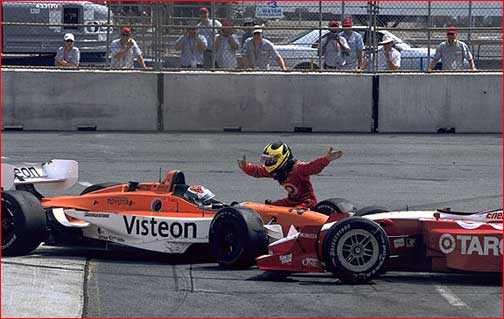 "After the Crash" Toronto Molson Indy 2002
"After the Crash" Toronto Molson Indy 2002
EOS 1-V and 70-200mm F/2.8 lens, 1/500th at f/8.0 on Provia 100F
When it comes to determining the correct exposure, I trust my camera’s built in meter to handle almost every on-track and pit lane situation. The only exception is shooting black cars from close range. You will have to dial in some underexposure to compensate. I usually shoot in aperture priority mode using the smallest f-stop I can afford. Much of the time you will not be able to rely on your autofocus. The cars are moving too fast for even the best hypersonic focusing motors to track. You can usually find a slow-speed corner (or the entrance to the pit lane) where your predictive-auto focus will track a car successfully, but the camera will frequently focus on the wrong part of the car. The solution is to pre-focus on a spot on the track, and press the shutter release button so that the shutter opens at the precise moment the driver’s head is in focus. These cars move at speeds approaching 245 miles per hour, and with a 300mm lens, depth of field will be measured in inches. You need to judge how far the car will travel during the lag between squeezing the shutter release and the time the exposure is made. It’s hard to do, but with practice you can obtain consistent results.
You will be able to use your autofocus when panning. A well executed panning shot will keep most of the car in focus against a blurred background. Blurred tires also help convey the sense of speed. The effect is achieved by panning with the car and gently releasing the shutter. Practice makes perfect with this technique — at their top speed of 245 mph, these cars travel almost 3 feet in 1/100th of a second! Practice following the cars without shooting any frames until you feel comfortable you can keep the car in the frame while panning smoothly. Use the fastest shutter speed you can and an Image Stabilized lens wherever possible.
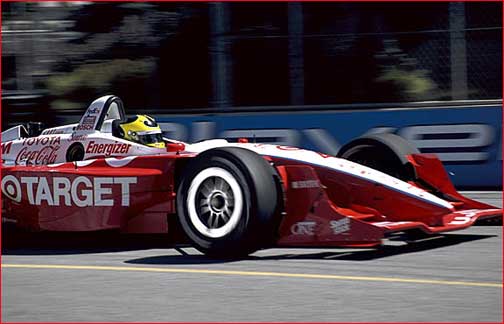 "Junqueria On Target" Molson Indy Toronto 2002
"Junqueria On Target" Molson Indy Toronto 2002
EOS 1-V and EF 28-135mm f/3.5-5.6 IS lens, 1/200th at f/8 on Provia 100F
The Results
My philosophy is that film is cheap and the race only happens once per year. Why be stingy on film? At this year’s race, I shot 21 rolls of Provia 100F – that is more than 750 exposures over 3 days. My 750 exposures yielded approximately 25 images that I thought were good, and only 8 or 9 that are good enough to post in this year’s gallery. Not a very high success rate at all. This is a unique form of photography, and you shouldn’t expect to achieve the same success rate you enjoy elsewhere. The high number of spoiled frames also practically explains why Canon’s 1-D digital camera has become so popular with professional sports photographers.
It takes a long time and a lot of practice to perfect your racing photography technique, but the process is very enjoyable. It’s a great way to spend a weekend enjoying a fascinating sporting event and creating some unique and exciting images.
Photographs and Text © 2002 Lee Carney
Lee Carneyis a Toronto-based business executive who takes his photography very seriously.
You May Also Enjoy...
The Luminous Landscape Video Journal
Exclusively About PhotographyBill Atkinson on Colour Management & Profiling Bill & Michael discuss the basics of colour management and profiling. Bill answers the questions, "What
